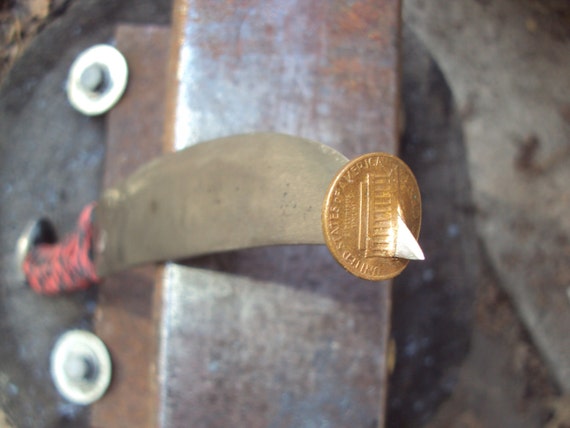

- Easiest way to finish a railroad spike knife manual#
- Easiest way to finish a railroad spike knife free#
The finished spikes shall conform to the dimensions specified by the purchaser, subject to the permissible variations specified in Table 2-1.Īll finished spiked shall be straight, with well formed heads, sharp points and be free from injurious defects and shall be finished in a workmanlike manner. If the spikes fail to meet the third test, they shall be rejected.Ģ.2.9 PERMISSIBLE VARIATIONS IN DIMENSIONS (1968) Spikes represented by bend tests failing to meet the requirements prescribed in Article 2.2.6a and Article 2.2.6b may be annealed and resubmitted.

Easiest way to finish a railroad spike knife manual#
One bend test of each kind specified in Article 2.2.6a and Article 2.2.6b shall be made from each lot of 5 tons or fraction thereof.ĥ-2-6 AREMA Manual for Railway Engineering

When the option in Article 2.2.5 is exercised, one tension test shall be made from each 10-ton lot or fraction thereof.ī. But no, it won't get as hard as another bit of steel with 30 points.Ī. Or look in chapter 6 of Principles of Heat Treatment of Steel by Krauss for a very good graph.Ī spike or other bit of steel with 20 points of carbon can indeed be hardened. Retained austenite can actually diminish maximum attainable hardness at carbon levels beyond this.) Run an internet image search with the terms "carbon" and "hardness" and a few renditions of this graph will show up. Maximum attainable hardness levels out around 60 or 65 points. The more carbon available, the more martensite which can be formed. The maximum attainable hardness of a given piece of steel versus the carbon content forms a curve on the graph. There is no magic number above which steel will harden or below which it will not. Make lower part of the railroad spike fully into the charcoal burn until railroad spike showing bright red color, use iron clamp clip the railroad spike out. No disrespect meant to a fellow electrician, but I'm going to get nitpicky here. Other helpful materials and tools that are needed include a wooden handle, chisel, spring swage, and a ball peen hammer.Īlternative tools and techniques are offered in the original video tutorials, so as long as you have the basics, you should be able to complete the following projects.No you cant HT a spike, sorry read about heat treating and you will understand that one needs at least 35 points of carbon to harden a steel For some of the projects listed below, vices and grinders are also helpful. Working with railroad spikes requires all the basic blacksmithing equipment: a forge, anvil, hammer, tongs, and punches. What Tools Do I Need for Railroad Spike Projects? Photo by U.S. If you are a beginner blacksmith wanting to create some functional pieces out of railroad spikes, or a seasoned smith who needs some project inspiration, check out the following project ideas and their corresponding YouTube videos. The shape of railroad spikes is also very accommodating for different types of small projects like the ones detailed below. Why work with railroad spikes?įor beginners wanting to refine their hammering technique and get more comfortable with the blacksmithing process in general, railroad spikes are a very forgiving, inexpensive material to practice with.

Although nontraditional, railroad spikes are common items that are reworked by blacksmiths. Like other crafts, there are no true rules that dictate what materials blacksmiths use. 1.2.10 10) Railroad Spike Wizard Face Railroad spikes are very cheap to acquire and quite forgiving for beginners looking for smaller projects.


 0 kommentar(er)
0 kommentar(er)
